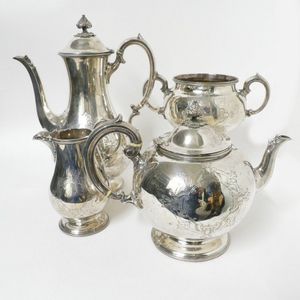George II Sterling Silver Cream Jug, London 1740
You must be a subscriber, and be logged in to view price and dealer details.
Subscribe Now to view actual auction price for this item
When you subscribe, you have the option of setting the currency in which to display prices to $Au, $US, $NZ or Stg.
- George Ii - George II (1683 - 1760) was King of Great Britain and Ireland from 1727 until his death in 1760.
- Sterling Silver - Sterling silver is a mixture of 92.5% pure silver and 7.5% of another metal, usually copper. Fine silver is 99.9% pure silver, and is relatively soft and the addition of the very small amount of copper gives the metal enough strength and hardness to be worked into jewellery, decorative and household objects.
- Acanthus - A stylized leaf motif, one of the primary decorative elements of classical Greek and Roman architecture, derived from the genus of flowering plants in the family Acanthaceae, native to tropical and subtropical regions of the Mediterranean area. It is a common element in classical Greek and Roman design, and is often seen in Corinthian and Composite order columns and used as a decorative element in English, European and Australian furniture, particularly on the curve of a leg, and as decoration for a corbel.
- Hallmarks - A mark stamped on articles of precious metals in Britain, since the 14th century, certifying their purity. It derives its name from the Guild Hall of the Goldsmiths' Company, who recieved its Charter in 1327 giving it the power to assay (test the purity) and mark articles of gold and silver.
The hallmark will consist of several marks, including the:
- silver standard mark, indicating the purity of the metal. Sterling silver is .925 pure silver.
- the city mark indicating the city in which it was assayed eg London, Birmingham, York etc.
- the date mark, usually a letter of the alphabet in a particular font and case,
- a duty mark, indicating whether duty had been paid to the crown, and only in use from 1784 to 1890
The piece may include an additional mark, the maker's mark, although not forming part of the hallmark, will be located in the vicinity of the hallmarks.
Sometimes silver plated items will bear faux hallmarks, often confusing those not familiar with silver markings.
This item has been included into following indexes:
- cream jugs and creamers - silver items 725
- jugs, cream
Visually similar items

A set of four Edward VII sterling silver lidded mustard pots, maker's mark Pierce & Sons Ltd, London 1908 and four sterling silver mustard spoons maker's mark Pierce & Sons Ltd, London 1908, each mustard pot 9 cm wide across the handle (one mustard pot wit

A George III silver pear shaped creamer, raised on three pad feet. Some faults. London 1743 by Edward Wood (marks rubbed). 78gms. Height 9 cm

A three piece Scandinavian silver coffee service, maker K. Anderson.

A Victorian silver four-piece tea and coffee service, the coffee pot with plain baluster body, the teapot of bullet shape, conforming sugar basin and milk jug, all with engraved vacant cartouches. Sheffield 1868 by Martin Hall Ltd. Total weight 2228gm
